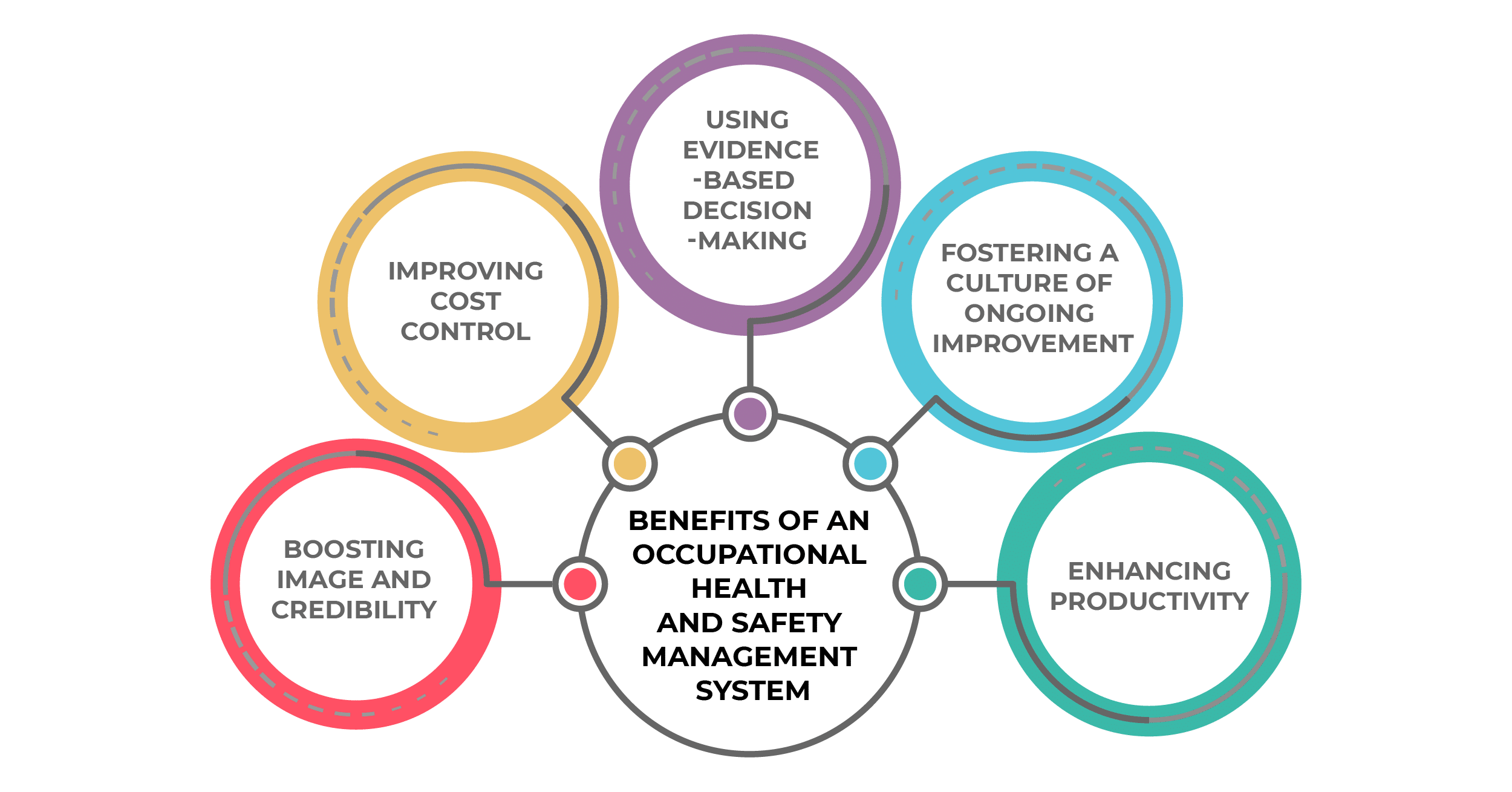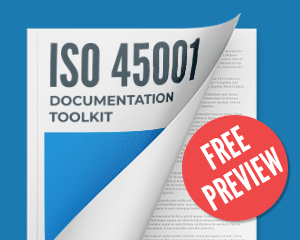An Occupational Health and Safety Management System (OHSMS) ensures that you have the necessary processes to achieve compliance with occupational health and safety legal requirements. But how should organizations go about implementing an OHSMS? In this article, we will discuss what an OHSMS is, and how it relates to ISO 45001.
The OHSMS provides a framework of processes that will help you to not only meet your legal OH&S compliance obligations, but to go beyond this to improve your OH&S performance and to prevent injury and ill health in the workplace. Having an OHSMS will help you to show due diligence in protecting worker health and preventing accidents in the workplace.
What is an Occupational Health and Safety Management System?
An Occupational Health and Safety Management System (OHSMS) is a framework that an organization uses to ensure the health and safety of its employees by preventing hazards and minimizing risks in the workplace. It includes:
- Rules – such as “Employees must wear hardhats in construction zones.”
- Policies – such as “No smoking within 50 feet of the building.”
- Processes – such as regular safety inspections of machinery and equipment.
- Plans – such as emergency evacuation routes posted throughout the building.
- Practices – such as monthly safety training sessions for all staff.
Each organization’s OHSMS is unique and must comply with legal requirements, address specific hazards, and fit with the organization’s business processes.
How does the OHSMS relate to ISO 45001?
ISO 45001 is the international standard that provides the requirements for the processes needed to implement an OHSMS — to prevent injury and ill health in the workplace. These are based on best practices from around the world, which have been agreed upon by more than 160 member nations of the International Organization for Standardization.
In 2018, ISO 45001 replaced an earlier standard, OHSAS 18001. This has given rise to some confusion between what OHSAS 18001 was, and the OHSMS that is implemented using ISO 45001.
For more information on this difference, you can see the article OHSAS vs OHSMS: What is the difference?
Steps to implement an OHSMS
Implementing an Occupational Health and Safety Management System and gaining ISO 45001 certification involves several steps, starting with gaining the support of management. Since the OHSMS is the structured way that we manage the business activities to prevent injury and ill health of workers, top management must be the ones to ensure that the management system has the necessary resources.
The OHSMS goes beyond just meeting legal requirements, and requires finding ways to understand and purposefully prevent hazards, which exist in every organization, from causing injury or ill health. To do this, you will need to put in place the processes needed to understand the hazards in your workplace, and what controls and procedures are needed to maintain and improve your OH&S performance.
You can read more about the steps to implement an OHSMS using ISO 45001 in the article 12 steps for implementation and certification against ISO 45001.
Benefits of an Occupational Health and Safety Management System
Implementing an OHSMS benefits the organization by preventing injury and ill health in the workplace. Here are just a few other benefits:
- Boosting image and credibility by demonstrating your organization’s care for its employees.
- Improving cost control by decreasing costly compensation claims and insurance premiums.
- Using evidence-based decision making to guide your improvement initiatives.
- Fostering a culture of ongoing improvement to engage your people and boost retention.
- Enhancing productivity by reducing absenteeism related to workplace accidents and illnesses.
These benefits collectively contribute to a safer, healthier, and more productive work environment, ensuring the long-term success and sustainability of the organization. However, not all organizations can so readily implement an OHSMS, particularly SMEs.
Challenges of an OHSMS for SMEs
There are three main challenges that affect SMEs when deciding whether to implement an OHSMS. These can get in the way of securing the management commitment for the project, which is the biggest success factor in the OHSMS implementation.
1) Can we afford it? Implementing an OHSMS and gaining ISO 45001 certification can be costly, but it can open up opportunities to compete for larger contracts.
2) Do we have the expertise? SMEs may lack a dedicated OHSMS expert due to smaller headcounts. To address this, familiarize yourself with ISO 45001 and assign a project manager.
3) Do we have enough resources and time? While implementing an OHSMS takes time, the prevention of injury and ill health can lead to savings in lost time and money.
The ideal project manager for OHSMS implementation is discussed in this article: Who is the ideal project manager for your ISO 45001 project?
Key success factors for the OHSMS
Implementing an OHSMS using ISO 45001 requires careful planning to ensure the system is implemented correctly the first time, saving time and money. Controlling challenges can maintain progress towards ISO 45001 implementation and keep the project on track.
Start on a firm foundation
Implementing an OHSMS is unique to each company. For success, it should align with the company’s specific needs, leveraging the ISO 45001 guide. The ISO 45001 requirements provide a good guide for the processes that need to be in place. However, the manner in which you implement these requirements is completely up to you and should be suited to your company’s specific needs.
Ensure the support of management
Even if it’s possible to overcome the struggle and successfully implement ISO 45001 without the full support of your management team, it will inevitably become challenging to maintain and uphold the system once it has been established. The lack of their buy-in could lead to a fragile infrastructure that may crumble over time without their reinforcement and support. Therefore, it’s critically important to sell this project to the top management now; you not only pave the way for a smoother implementation, but also ensure that the system remains robust and effective as you maintain it going forward.
Four fundamentals for the OHSMS
To create an effective OHSMS, it’s crucial to begin with four fundamental elements. These elements form the backbone of your management system, and, if they are established first, they will provide a solid foundation for building the rest of your processes:
- OH&S Policy: The policy outlines the company’s commitments and direction regarding OH&S factors, providing a framework for all health and safety decisions.
- Legal requirements: Understanding and updating knowledge of the legal requirements that apply to your business is crucial for constructing a compliant management system.
- OH&S hazards: Identification of potential health and safety issues within company processes allows for the creation of control measures and mitigation strategies.
- Objectives and plans: Setting clear objectives and detailed plans is essential for facilitating and measuring improvements in the OH&S Management System.
Set up for maintaining the OHSMS
One way that the OHSMS implementation is different from other projects is that, when it comes to an end, the processes will still need to be maintained on an ongoing basis. To this end, it is important that, as you are implementing processes, you ensure that whoever is going to be responsible for this process has all of the knowledge needed to ensure that the process continues to be effective and efficient, and that it improves over time. These people who are responsible for the processes are typically called process owners.
One of the best ways to address these challenges is to ensure that you include those who will be maintaining the processes of the OHSMS during the implementation of their processes. This way, you will have a knowledgeable group of process owners who know how to manage and improve the OHSMS going forward; and, if there are any questions on the policies, hazards, or implementation of the OHSMS, it will be simple to gather all of the necessary information to promote worker participation in the management system.
You can read more about the success factors for OHSMS implementation in this article: 5 tips to make your ISO 45001 implementation project successful.
Conclusion
Workplace safety is not just a good idea; it’s critical for maintaining a healthy workforce who are better able to complete the work and tasks that are needed in the business. Implementation is only the first step towards improving occupational health and safety performance.
Once you have put all of the necessary processes in place, you must improve them over time, further preventing injury and ill health in the workplace. By maintaining the OHSMS as you implement it, you’ll be better prepared to continue with this improvement activity in the future.
Overcome OHSMS challenges and simplify the implementation using this ISO 45001 Premium Documentation Toolkit — it will provide all the required OHSMS documents and guidelines for the implementation.

 Mark Hammar
Mark Hammar

